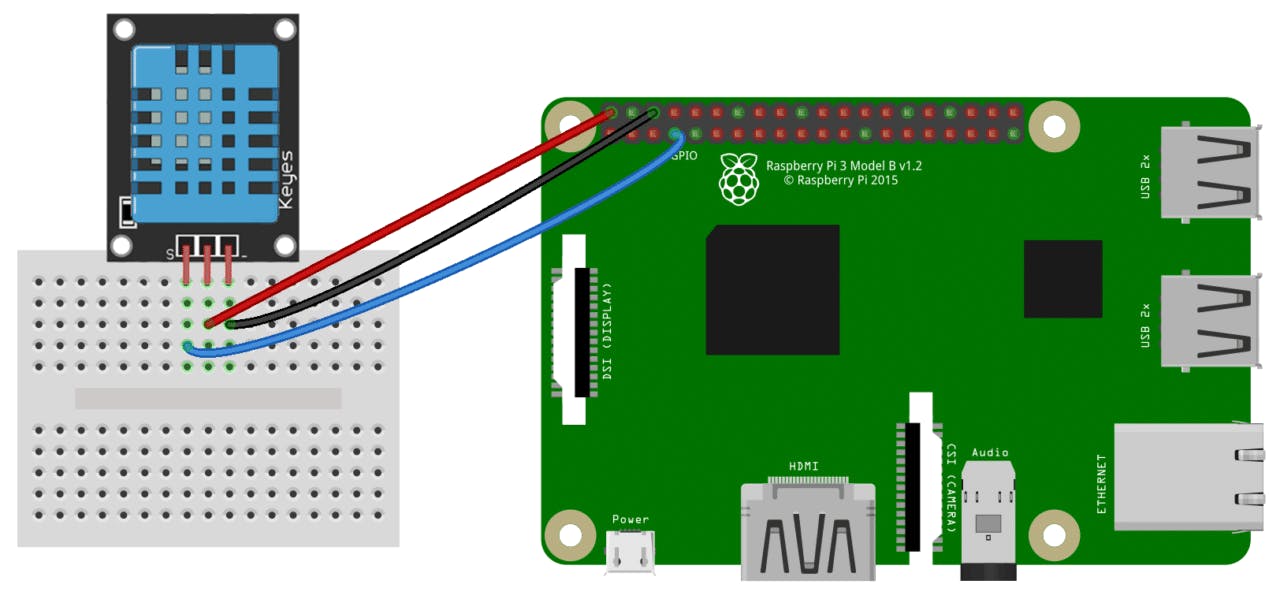
资料下载

带Wep接口的智能加热器
描述
问题
我必须不断调整我的加热器以保持合适的温度。此外,有时我离开家时忘记关掉暖气。
解决方案
设置温度和运动传感器以捕获环境数据。创建一个网络应用程序,允许用户设置他们想要的温度,这将控制加热器的关闭或打开方式。
这是一个图表,显示了一切将如何交互。

第 1 步 - 使用 Raspberry Pi 设置传感器
获得 DHT11 温度和 PIR 运动传感器后,是时候将其连接到 Raspberry Pi。
以下是如何连接 DHT11 温度传感器。我放弃了面包板并使用引脚 1(3V3)而不是引脚 2(5V)供电,从而偏离了图表。

以下是如何连接 PIR 运动传感器。LED 连接是可选的。我通过将 Gnd 连接到引脚 20(接地)而不是引脚 6(接地),输出到引脚 36(GPIO 16)而不是引脚 8(GPIO 14)和 LED 连接到引脚 40(GPIO 21)而不是引脚 10(GPIO 15)。


两者连接时的最终结果:
这里我的 PIR 传感器连接到 GPIO 16,DHT11 连接到 GPIO4。温度传感器应放置在您想要获得正确温度的位置,而运动传感器应朝向您通常所在的位置。
第 2 步 - 编写代码来测试传感器
下面是测试运动传感器的 Python 代码(不要忘记在此处安装 RPi.GPIO https://pypi.org/project/RPi.GPIO/ ):
import RPi.GPIO as GPIO
from time import sleep
GPIO.setmode(GPIO.BCM)
motion_pin = 16
led_pin = 21
GPIO.setup(motion_pin, GPIO.IN)
GPIO.setup(led_pin, GPIO.OUT)
print("Sensor initializing . . .")
sleep(2)
try:
no_motion_count = 0
while True:
if GPIO.input(motion_pin) == True:
print("Motion Detected!")
GPIO.output(led_pin, True)
sleep(4)
GPIO.output(led_pin, False)
no_motion_count = 0
else:
no_motion_count += 1
print(f"No Motion Count: {no_motion_count}")
sleep(1)
except KeyboardInterrupt:
pass
finally:
GPIO.output(led_pin, False)
GPIO.cleanup()
下面是测试温度传感器的 Python 代码(不要忘记在此处安装 Adafruit_DHT https://pypi.org/project/Adafruit_Python_DHT/ ):
import Adafruit_DHT
from time import sleep
temperature_humidity_sensor = Adafruit_DHT.DHT11
gpio_pin = 4
try:
while True:
humidity, temperature = Adafruit_DHT.read_retry(
temperature_humidity_sensor, gpio_pin)
if humidity is not None and temperature is not None:
print(
'Temp={0:0.1f}*C Humidity={1:0.1f}%'.format(temperature, humidity))
else:
print('Failed to get reading. Try again!')
sleep(0.5)
except KeyboardInterrupt:
pass
这是两者结合的代码:
import RPi.GPIO as GPIO
import Adafruit_DHT
from time import sleep
GPIO.setmode(GPIO.BCM)
# Motion
motion_pin = 16
led_pin = 21
no_motion_count = 0
GPIO.setup(motion_pin, GPIO.IN)
GPIO.setup(led_pin, GPIO.OUT)
def handle_motion(no_motion_count):
if GPIO.input(motion_pin) == True:
print("Motion Detected!")
GPIO.output(led_pin, True)
sleep(4)
GPIO.output(led_pin, False)
no_motion_count = 0
return 0
else:
return no_motion_count + 1
# Temperature + Humidity
temperature_humidity_sensor = Adafruit_DHT.DHT11
gpio_pin = 4
def handle_temperature():
humidity, temperature = Adafruit_DHT.read_retry(
temperature_humidity_sensor, gpio_pin)
if humidity is not None and temperature is not None:
print(
'Temperature = {0:0.1f}*C Humidity = {1:0.1f}%'.format(temperature, humidity))
return temperature
else:
print('Failed to read Temperature/Humidity')
# Run Program
print("Sensor initializing . . .")
sleep(5)
try:
no_motion_count = 0
desired_temperature = 28
desired_temperature_margin = 2
while True:
temperature = handle_temperature()
no_motion_count = handle_motion(no_motion_count)
if no_motion_count >= 20:
print(f"No Human Detected.")
elif temperature > desired_temperature + desired_temperature_margin:
print(f"Temperature Too High")
elif temperature < desired_temperature - desired_temperature_margin:
print(f"Temperature Too Low")
else:
print(f"Temperature Just Right")
print(f"No Motion Count: {no_motion_count}")
sleep(0.25)
except KeyboardInterrupt:
pass
finally:
GPIO.output(led_pin, False)
GPIO.cleanup()
第 3 步 - 开发 Flask API 以公开传感器数据
在我们可以让传感器工作之后,它的服务时间是通过一个 API,在本例中是一个 Flask API。下面是重要的代码,但请参考我的 GitHub 存储库https://github.com/sometheasiekswx/smart-heater-api-flask以查看所有代码(不要忘记在此处安装 Flask https://flask .palletsprojects.com/en/2.0.x/quickstart/和 Flask-CORS 在这里https://flask-cors.readthedocs.io/en/latest/ ):
from operator import itemgetter
from signal import signal, SIGINT
from sys import exit
from time import sleep
import RPi.GPIO as GPIO
from Adafruit_DHT import DHT11, read_retry
from flask import Flask
from flask_cors import CORS
GPIO.setmode(GPIO.BCM)
# Motion
motion_pin = 16
led_pin = 21
no_motion_count = 0
GPIO.setup(motion_pin, GPIO.IN)
GPIO.setup(led_pin, GPIO.OUT)
# Temperature + Humidity
temperature_humidity_sensor = DHT11
gpio_pin = 4
# Run Program
print("Sensor initializing . . .")
sleep(5)
app = Flask(__name__)
cors = CORS(app, resources={r"/api/*": {"origins": "*"}})
no_motion_count = 0
desired_temperature = 28
desired_temperature_margin = 2
@app.route("/api/v1/temperature")
def get_temperature():
humidity, temperature = read_retry(
temperature_humidity_sensor, gpio_pin)
if humidity is not None and temperature is not None:
return str(temperature)
return 'Unknown'
@app.route("/api/v1/motion")
def get_motion():
if GPIO.input(motion_pin):
GPIO.output(led_pin, True)
return "true"
GPIO.output(led_pin, False)
return "false"
def has_no_empty_params(rule):
defaults = rule.defaults if rule.defaults is not None else ()
arguments = rule.arguments if rule.arguments is not None else ()
return len(defaults) >= len(arguments)
@app.cli.command()
def routes():
'Display registered routes'
rules = []
for rule in app.url_map.iter_rules():
methods = ','.join(sorted(rule.methods))
rules.append((rule.endpoint, methods, str(rule)))
sort_by_rule = itemgetter(2)
for endpoint, methods, rule in sorted(rules, key=sort_by_rule):
route = '{:50s} {:25s} {}'.format(endpoint, methods, rule)
print(route)
@app.route("/")
def main():
return """
Smart Heater API
Endpoint
Method
Rule
get_motion
GET
/api/v1/motion
get_temperature
GET
/api/v1/temperature
"""
def cleanup(signal, frame):
print('Closing API...')
GPIO.output(led_pin, False)
GPIO.cleanup()
exit(0)
signal(SIGINT, cleanup)
在 Raspberry Pi 上添加代码后,以下是如何运行代码以及访问在 Raspberry Pi 上设置的端点时应该得到的结果(尝试从同一网络上的不同设备访问端点以测试是否CORS 策略正常工作):

第 4 步 - 使用 IFTTT 设置智能插头
此步骤将根据您碰巧选择的支持 WI-FI 的智能插头品牌而有所不同。对我来说,我选择了Powertech Wi-Fi Smart Plug ,这需要我使用Smart Life应用程序进行设置。无论您使用哪种品牌,请按照说明连接插头。然后,转到IFTTT ,创建一个帐户,然后搜索 IFTTT 与您的智能插头应用程序的集成。
设置两个小程序。第一个触发器是是否触发了关闭加热器的 GET 请求(事件名称 temperature_high)。第二个触发器是是否触发了打开加热器的 GET 请求(事件名称 temperature_low)。

第 4 步 - 开发 React 前端来控制一切
最后,我们将开发这个漂亮的前端:

我使用 ReactJs 和 TailWindCss 来创建 Web 应用程序,因此它可以帮助您拥有这些技术的先前经验。是帮助您入门的完美资源。您还可以使用您喜欢的任何其他框架(Angular、Laravel)或语言(HTML + CSS + JSS)来构建网站。
共有三张卡: 1. 温度传感器,显示当前温度,可以设置目标温度 2. 运动传感器,我们可以看到是否检测到任何运动,如果太长时间没有检测到运动,我们可以自动关闭加热器 3. 加热器状态为关闭或开启,也可手动控制智能加热器系统关闭。
这是我们从前端进行 API 调用的示例:
import axios from 'axios';
const sensorsApi = axios.create({
baseURL: `http://${process.env.REACT_APP_API_HOST}:${process.env.REACT_APP_API_PORT}/api/v1/`,
});
const heaterApi = axios.create({
baseURL: `https://maker.ifttt.com/trigger/`,
});
export const turnOffHeater = async () => {
try {
await heaterApi.get(`temperature_high/with/key/${process.env.REACT_APP_IFTTT_WEBHOOK_KEY}`);
} catch (error) {
console.log(error.message);
}
}
export const turnOnHeater = async () => {
try {
await heaterApi.get(`temperature_low/with/key/${process.env.REACT_APP_IFTTT_WEBHOOK_KEY}`);
} catch (error) {
console.log(error.message);
}
}
export const getTemperature = async () => {
try {
const data = (await sensorsApi.get('temperature')).data;
return parseFloat(data);
} catch (error) {
console.log(sensorsApi)
console.log(error.message);
}
}
export const getMotion = async () => {
try {
const data = (await sensorsApi.get('motion')).data;
return data === 'true';
} catch (error) {
console.log(error.message);
}
}
这是我如何使用这些异步函数的示例。它还显示加热器将根据它是否低于或高于目标温度来打开和关闭。
import {useEffect, useState} from "react";
import {getMotion, getTemperature, turnOffHeater, turnOnHeater} from "../utils/api";
import {CronJob} from "cron";
function Devices() {
const [currentTemperature, setCurrentTemperature] = useState(0);
const [targetTemperature, setTargetTemperature] = useState(25);
const [targetTemperatureMargin] = useState(2);
const [heaterOn, setHeaterOn] = useState(false);
const handleTemperature = async () => {
const temperature = await getTemperature();
setCurrentTemperature(temperature);
console.log(currentTemperature, targetTemperature);
if (currentTemperature >= targetTemperature + targetTemperatureMargin && heaterOn) {
await turnOffHeater();
setHeaterOn(false);
} else if (currentTemperature <= targetTemperature - targetTemperatureMargin && !heaterOn) {
await turnOnHeater();
setHeaterOn(true);
}
}
const [jobTemperature] = useState(new CronJob("* * * * * *", handleTemperature()));
以下是运动逻辑的设置方式:
const handleMotion = async () => {
const newMotion = await getMotion();
if (newMotion === false) {
setNoMotion(noMotion + 1)
} else {
setNoMotion(0)
setMotion(true);
}
if (noMotion > 50) {
setMotion(false);
}
}
最后的想法
我在这里只展示重要的代码,你可以在附件中找到整个前端和后端代码库,以及完成这个项目所需的电子设备和传感器。祝你好运!
声明:本文内容及配图由入驻作者撰写或者入驻合作网站授权转载。文章观点仅代表作者本人,不代表电子发烧友网立场。文章及其配图仅供工程师学习之用,如有内容侵权或者其他违规问题,请联系本站处理。 举报投诉
- 相关下载
- 相关文章






